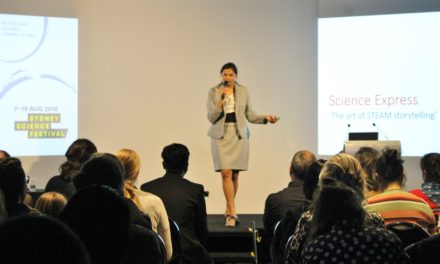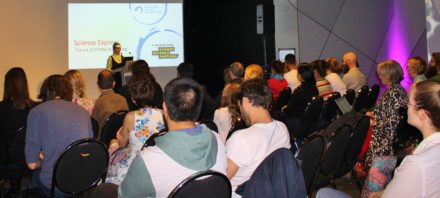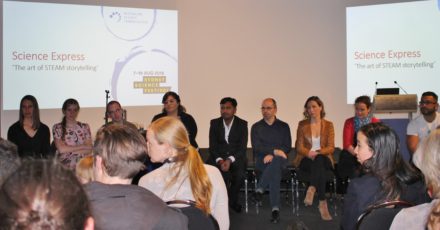A Science Communication professional development evening at the Sydney Science Festival – Review by Astha Singh
Nine young and upcoming science, technology, engineering and mathematics (STEM) researchers took over ‘The Lab’ at the Powerhouse Museum (Museum of Applied Arts and Sciences) on 15th August. The agenda was to have conversations with a full house about how to approach, talk about and communicate STEM concepts. As a science communications and outreach professional I was elated to be joined by some rising stars in STEM research to advocate for quality science communication. The line-up included; Alfonso Ballestas-Barrientos (USYD) Chemist working on clean energy generation, Angela Crean (USYD) Evolutionary ecologist and veterinary scientist, Isabelle Kingsley (UNSW) Science communicator, educator and researcher, Jonathan Plett (UWS) Fungi and plants researcher, Muthu Vellayappan (Monash) Human heart research, Nural Cokcetin (UTS) Medicinal uses of honey, Richard Charlesworth (UNE) Diagnosing Coeliac disease, Toby Hendy (ANU) Physical and mathematical structures in nature and biology, Vanessa Pirotta (Macquarie University) Whale conservation researcher using drones technology to monitor whale health.
This very diverse, award-winning and exuberant group of scientists reflected on their experiences with #Scicomm, techniques, implications of concise communication and the impact of their work on the public and policy makers. Out of all the ideas from the speakers, I’m going to list the top 10 takeaways that I compiled from #ScienceExpress2018
1. The concept: A few speakers in the evening emphasised on how important it is to know your work inside out. Knowing all aspects of any topic is most likely impossible however you are the master of your area of research. It is highly imperative to have the clarity of the concept that you will be talking about. There is no harm in undertaking some more research on some other areas that relate to your topic and have clarity of the ideas that relate to your concept.
2. Jargon and complications: Science is messy! Even though all parts of STEM research entail complexities and different kinds of jargon, it is always necessary to keep it simple.
3. Elevated pitch: When you sprinkle some life and energy into your talk or presentation it depicts the passion you have for your work and makes it easy for you to be able to make an impact on the audience who also might be important connections within your industry.
4. Own the unique: Today, we are quite a diverse range of professionals in the STEM industry and therefore it becomes even more important to keep your uniqueness and own it. You could be unique at anything – skills, persona, sense of humour, nationality, ethnicity or anything else that makes you stand out. Use it to your advantage; For example, if you are a YouTuber – say it!
5. Impact: It is important to make an impact via your work and what you are trying to communicate. This impression is more necessary for policymakers and government officials to be positive and should lean towards making a tangible change.
6. Who and what: This one is well known to all – know your audience and where you will be speaking. Practice with a diverse set of audiences and keep a tab on their positive reactions. Use the content that made a positive impact on your own audience again and again.
7. Connection: When you talk to a new audience, try to make an instant connection with them in the first 30 seconds. This will boost their attention towards you. Use analogies, have your own stories to tell them and they will not forget your message. There is also no harm in sprinkling some emotion in your pitch.
8. Body language: Your body language says a lot about your work. Be open as it encourages open conversations and adds more genuineness to your speech. Positive hand gestures are a great example of open body language.
9. Honesty: Be honest. Ensure the credibility and authenticity of your work prior to preparing the speech. Misleading your audience is the last thing you would like to do. If you don’t know something that is being asked, say you don’t know. This provides an opportunity for future conversation about the topic later with some meaningful growing connections.
10. Smile: This adds a whole lot of flavour to your speech. Communicate the concept with a smile and you will already have made quite an impact on your audience. If it is a younger demographic of audience, smiling will instantly develop open communication. Other face expressions while explaining different concepts also helps to provide genuineness to your talk.
Note: These ideas are a combination of what was discussed on the evening by the nine speakers listed above. All credits are directed towards the speakers.



